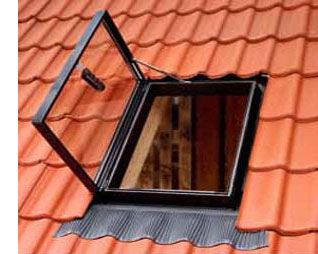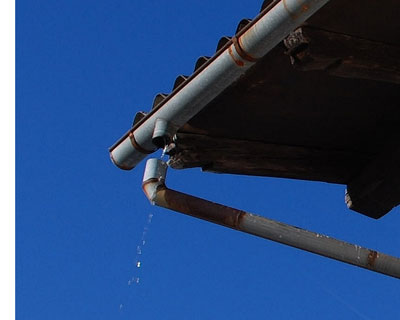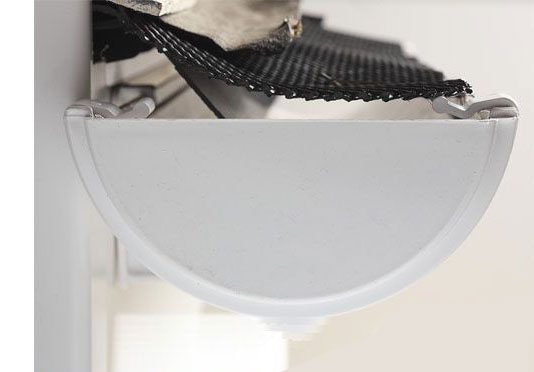Roof repair can seem like a daunting task but not every roofing problem is a costly, inconvenient fix. Most leaks, stains or mysterious smells are pretty easy to identify the cause of, and regular maintenance will prevent any long-term issues. It’s important to note that some problems are easiest to fix before they happen. For example, flashing that’s leaking can be spotted early on by just some common-sense checks. If it goes unchecked it can develop over many years into an expensive repair bill as wood gets rotted and mouldy.
Table of contents:
- Leaks and stained ceilings
- Loose and unsecured gutters
- Overflowing gutters
- Other common problems
- Top tip for maintenance
Leaks and stained ceilings
Leaks and stained ceilings are unsightly, they can smell, and they seriously devalue a home to prospective buyers even if the problem isn’t that big.
The cause
Water leaking down walls from the ceiling or water-stained ceilings can be a result of one, or unfortunately several, small problems in a roof. If there’s water leaking down walls very heavily and the issue has onset quickly then we recommend contacting a roofer immediately as it sounds like a much bigger issue.
 Some of the small problems that can cause water leaks into the home and stained ceilings include water leaking through missing or badly installed tiles, punctures in the roofing membrane, and flashing not being installed correctly either.
Some of the small problems that can cause water leaks into the home and stained ceilings include water leaking through missing or badly installed tiles, punctures in the roofing membrane, and flashing not being installed correctly either.
A small leak in the flashing or the membrane can be easy and inexpensive to repair so it’s worth doing as soon as the problem is identified so that the problem doesn’t get worse!
Top tip: Investigate leaks and stains as soon as you see them, and don’t put off any work just because other work is scheduled. If you’re planning on getting a new roof in the new year, leaving damages to get worse could put thousands on the cost of this.
Loose or unsecured gutters
Gutters that come loose run the risk of pulling down the fascia and soffits it’s attached to which will expose elements of the roof underneath. It’s easier and less expensive to address gutters that have come loose or weren’t secured properly in the first place than it is to re-fix fascias and soffits around the perimeter of the roof. Similarly overflowing gutters can cause issues as it can make entering and leaving the home difficult, and it can mean that all the rainwater flows to one place and perhaps pools in the garden or on a footpath.
The cause
If gutters were never secured properly in the first place then something simple like a storm or a child swinging on the downpipe can pull the whole guttering system loose. It may be more complex than this though as things like a gutter block from leaves or debris can cause gutters to overflow which can put more strain on the fixings than they were designed for. Screws that fix the gutter lengths to the fascia may also not have been the correct size or the correct material which can exacerbate the issue.
 Gutter lengths are fixed with brackets to the fascia at regular intervals, as recommended by the manufacturer. This is dictated by the material the guttering is made from (how heavy it is) and the capacity of the guttering (how heavy it will be assuming the gutter is handling water at maximum capacity). If the guttering has been installed with fewer brackets than it needs, this can cause the guttering to come loose too.
Gutter lengths are fixed with brackets to the fascia at regular intervals, as recommended by the manufacturer. This is dictated by the material the guttering is made from (how heavy it is) and the capacity of the guttering (how heavy it will be assuming the gutter is handling water at maximum capacity). If the guttering has been installed with fewer brackets than it needs, this can cause the guttering to come loose too.
Top tip: When you have new gutters installed, ask the installer what the recommended amount of brackets is per run of the gutter and compare this to what you know. There’s no harm in double-checking at all.
Overflowing gutters
Overflowing gutters are really easily caused by a small blockage in the gutter runs or in the downpipe. Something as simple as a bundle of leaves could build up in the downpipe for example and cause a blockage. Since the water can’t get through like it’s supposed to, it only takes a small amount of rain for the gutters to reach capacity and overflow. When they overflow it can make access to and from a property very unpleasant as the water can run over all of the edges like a waterfall, or it can all be pushed to one place. When this happens it means that water can pool somewhere or it can seep down to the foundations of the house. In the short term, this may not cause issues but after a while, it can weaken foundations and cause rot or damp if it’s consistently dripping down one wall.
 Top tip: You can have gutter guards installed alongside the new gutter runs to ensure no debris clogs up the gutters and the downpipe. These are available for as little as £324.10 (ex.VAT) so it’s a very affordable option which can be retrofitted without any need to remove gutters. If this isn’t an option for you you could get your gutters cleaned frequently by professional services.
Top tip: You can have gutter guards installed alongside the new gutter runs to ensure no debris clogs up the gutters and the downpipe. These are available for as little as £324.10 (ex.VAT) so it’s a very affordable option which can be retrofitted without any need to remove gutters. If this isn’t an option for you you could get your gutters cleaned frequently by professional services.
What are some other common roof repair issues?
There are a few common roof repair issues that can be fixed easily and that can be spotted upon installation of something new.
- It’s worth double-checking the installation of a skylight to ensure there’s no obvious place where it can leak. After the installation check after it rains for the first time that no water has seeped in.
- Double-check flashings and the area around them to make sure there’s no leakage there either. Chimney flues and vent pipes for example could leak if the flashing isn’t installed properly.
- Wind can cause TV aerials, trees and other bits of debris to blow into the roof and dislodge roof tiles. If there’s a tree overgrowing your roof, it may be worth chopping this back.
Top tip: Check your loft in the winter 
In the winter your roof will truly be tested against the elements so there’s no better time to check it. It’s windy, wet and cold so it’s the perfect time to check if there’s any rain being driven in, if there are any damp smells, or if there’s an excessive breeze.
Of course, you should expect a certain level of cold and wind in an uninhabited and uninsulated loft space but if there are noticeable patches of wet wood or insulation then mould could develop and rot could set in. The same goes for the breeze – if the breeze is too strong you may have tiles missing. You’ll need to use your discretion when assessing this!











